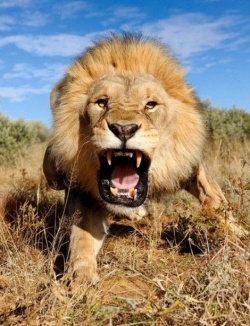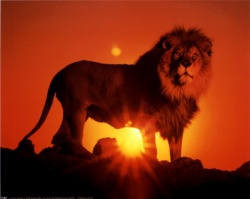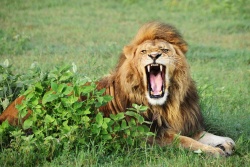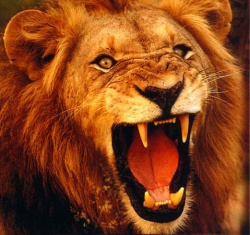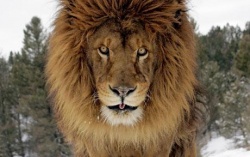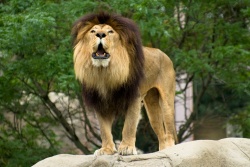Lion Symbolism
Buddha Shakyamuni is referred to as Lion of the Shakya (his clan) and is therefore depicted seated on the lion throne. Long before that time (6th-century BCE) the lion had assumed its association with royalty in general, and especially the role of vehicle [Skt. vahana) "familiar" or animal associated with divinity.
From early on, whenever Buddha is shown seated, there are eight lions -- one at each corner of the base or dais -- supporting his lotus throne.
Astrology
The lion was once the leader of the procession of constellations, and therefore is considered the King of Beasts.
Because of the wobbling path of the earth as it moves against the backdrop of the heavens, (recorded as Hamlet's Mill, or in Indian mythology as the Churning of the Sea of Milk -- the Milky Way) the first or Spring astrological sign changes every 26 thousand years. This causes the day of equinox (the couple of days in the year when daylight and night hours are equal) to shift over time, and results in a precession of the equinoxes. Precess means to get closer, to come nearer.
The precession has affected astrology, which would cause any skeptic to further question the validity of contemporary natal-chart interpretation.
Researchers find that around 10, 500 BCE, the pyramids at Gizeh perfectly mirrored the placement of the three belt stars in the constellation Orion. At that time (early Old Kingdom of Egypt) Leo, the pattern of stars seen as the form of a Lion, was the spring sign. For people in the northern hemisphere, when the Lion constellation appeared in the night sky, it heralded the cycle of growth.
Some scholars believe that the monumental Egyptian Sphinx once stood at the very edge of the Nile Delta facing the appropriate constellation as it rose. When there was a correspondence of position, the flooding of the Nile was anticipated. Today, the sphinx bears a much-too small human head (in proportion to its crouching body) but that may not always have been the case.
Perhaps not all pre-historic peoples viewed that formation of stars as a lion, but when they did, for a long time that animal was associated with the initial steps in fertility of the land. In Egypt, it was also associated with Osiris, the deity who was both the culture hero who introduced agriculture, and the one associated with the resurrection of the dead.
Narasimha
The 4th avatar or form of Lord Vishnu is as Narasimha, the Hindu deity who is part lion, part man. Emerging from a golden pillar, in the form of a giant, Narasimha vanquished the ashuras and subdued their king.
The lion is called simham in Sanskrit. Today, it is pronounced singh in northern India. Many Sikhs took this as their surname sometime in the late 17th-century when the synthesis of Hinduism and Islam which is Sikhism emerged as a separate religion entirely.
Vehicle of Goddesses
Qadesh or Qetesh, the Egyptian goddess of love and beauty was generally depicted nude and standing or riding upon a lion holding flowers, or sometimes, a mirror, or snakes. She is one of the rare deities to be depicted full-face (rather than in profile.) Beloved of Ptah, she is consort of Min and mother of Reshep. That she is a form of the Syrian love/fertility goddess seems obvious for in Semitic languages, her name means "Consecrated."
Anyone observant of the behaviour of lions in the prides, will recognize that the maned, male lion is not the leader as far as hunting goes; the lionesses certainly out-perform him. And it is the lioness -- in fact, a pair of them -- that are associated with the Great Goddess of very ancient times known in classical times as Kybele (Cybele, pron. Koubili.) In fact, In a Chariot Drawn by Lions is the title of an important book by A. Long on the subject of goddesses.
Popular fiction writer, Anne Rice wrote one of her earlier (1993) vampire novels, Queen of the Damned, inspired by this figure.
Not surprisingly, the lion is one of Durga, the Indian great protector goddess's vahanas (along with the tiger, and the black goat.)
A mythological, turquoise or lapis lazuli blue-maned, white lion known as a snow lion, has become the national symbol of Tibet. And Achi Chokey Dolma is the protector who rides this lion. In that way, she is the counterpart of India's goddess, Durga.
It is thought that the ancestors of the Sakyas came from central Asia where, as the Persians have described, the lion still roamed the land. It may have been their totemic animal. In any event, it is the animal most often associated with the Buddha in all cultures. And he himself is often referred to as Lion of the Shakyas.
There is also the fact of the golden hue of a lion's coat that reminds us of the traditional description of Shakyamuni's complexion.
The Lion's Roar
"The Lion's Roar" is a metaphor for the Awakening Doctrine of the Buddha.
Chögyam Trungpa Rinpoche introduced the tantric system to Western students in The Lion's Roar.
Karmapa: The Lion Begins to Roar, is a video by Ward Holmes (85 min.) on the first teachings of 17th Karmapa, Urgyen Trinlay Dorje.
Fa-hsien, the Chinese pilgrim who toured India in 400 CE, tells us that at Sarnath where King Ashoka had erected one of his edict pillars, there was living a group of monks. When a member of an opposing sect questioned their right to live there, the lion emblematic of Buddhism that sits atop the post gave a loud roar which frightened him away.
"What do you do when the stone lion roars?" is a Zen Buddhist koan.
Mevlana Jalaluddin Rumi (Mohammed b. Md. b. Hussain al-Balkhi, 1207-1273) founder of Tassawuf (Sufi) Islamic sect, also made reference to the roar (Feeling the Shoulder of the Lion. Putney, VT: Threshold Press, 1991): Once a farmer went out on a moonless night to check on an ailing mule. He could not know that there, in the dark shed where there was no ray of light, a lion had lain down in place of the mule. The farmer unwittingly puts out his hand and, there in the utter darkness, he touches the shoulder of the lion.
His heart is stirred and he reassuringly pats that shoulder. If he could see what he was doing, he would surely have heart failure. Rumi uses this situation as a metaphor for that mysterious occasional contact that produces a roaring in us. As Zen teacher Susan Murphy says, "... to hear it is to be devoured by it, torn free from all habitual familiarity into a familiarity far more profound and terrifying."
Lion-dogs
In Chinese architecture two lions, often referred to as "lion dogs" or Fo-, ie. Buddha-dogs are placed outside grand residences and institutions as protectors/guardians. Also known as Shi-shi, one is a male playing with a ball of ribbon, and the other is a female with her cub. Their mouths are shaped to form, respectively, the mantric sounds AH and HUM. The golden-red breed of dog known as the Pekinese (named after the capital city of Peking, now Beijing) was developed to resembled those protector lions. Longhaired cats are sometimes shorn to resemble these guardians.
Lion-face Dakini
Sakhmet (or Sekhmet) was the lion-headed form of the Egyptian goddess Hathor in her manifestation as destroyer. In this case, the lioness aspect is considered a solar symbol. She illuminates the darkest corners, burning out the opposition.
Simhamukha (Tib.: Senge-dongma) tangka at Baikal (Russian) site. She is bright blue with a white/pink face and green hair. In this form which derives from the Chakrasamvara cycle, she is not regarded as the embodiment of Guru Padmasambhava. A practice in which she resembles Vajravarahi was founded by a woman, Jetsun[ma] Lochen.
Simhamukha as queenly form of Padmasambhava or Guru Rinpoche; with companions dancing on the 6-pointed star of 2 interlocking triangles evocative also, of Vajravarahi.
Lion of Judah
Each of the 12 Tribes of Israel (descendants of the sons of the Hebrew patriarch Jacob) had an emblem. That of the tribe of Judah was a lion. Judah was a group whose southern territory included the capital city, Jerusalem where the kings ruled. The Romans called the united Israel-Judah territory Judea after it, and the Jews received their name from that.
Ras Tafari took the name Hailie Selassie on becoming first emperor of Ethiopia (1929.) To emphasize his link with the tradition that the Queen of Sheba (a land thought to be Ethiopian, was a consort of Solomon, King of Israel, he adopted the Lion as his emblem and Lion of Judah as one of his titles. (Others think Sheba was in Yemen.) The primarily Jamaican, Rastafarian movement takes its name from his, and identifying with the African Biblical tradition, uses that Lion as its symbol.
According to a 19th-century scholar, that Lion is the same as the one on the standard (flag) of the United Kingdom (England, Ireland, Scotland and Wales.)
Other Associations
Compassion and Karma
Androcles and the Lion: Folktale collected by Jacobs. (Androcles means Pride of Man.)
Prophecy
(Daniel 6: 1-28) The protection of God is manifest as the mouths of the ravening beasts are kept closed when Daniel is thrust into the Lions' Den by Darius, King of the Persians. (17th century Peter Paul Rubens' painting.)
Discipline
The tarot card (Marseilles deck) called La Force meaning, Strength. It is number 11 of the 22 Major Arcana, an encouraging indication that comes after the midpoint of the symbolic evolution that is the original deck. (The cards begin with the Fool, number 0.) It is often seen as the triumph of discipline over desire that culminates in the end to rebirth which is what is emphasized by the eternity symbol in the hat.
